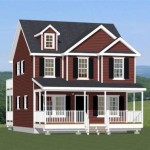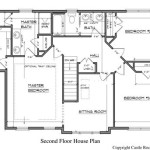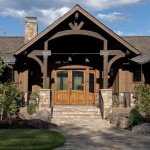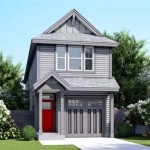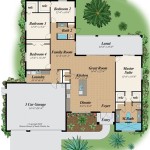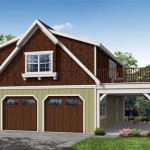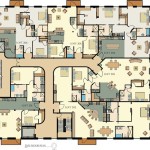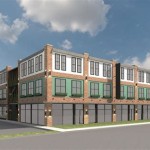L-Shaped Floor Plans: Maximizing Space and Functionality in Home Design
L-shaped floor plans are a popular architectural design characterized by two wings that intersect at a right angle, resembling the letter "L" when viewed from above. This format offers a compelling alternative to traditional rectangular or square layouts, providing specific benefits related to space utilization, zoning potential, and exterior design flexibility. The structure's configuration typically separates distinct living areas, such as public and private spaces. The L-shape plan is adaptable to different home sizes and architectural styles, making it a versatile choice for homeowners seeking functionality, aesthetics, and enhanced living experiences.
The genesis of the L-shaped floor plan can be traced back to the desire for clearer demarcation of living zones within a home. Early architectural adaptations aimed to create natural divisions between areas like living rooms and bedrooms or kitchens and dining rooms. This design evolved alongside changing domestic needs, reflecting a growing emphasis on privacy, open-concept living, and seamless integration of indoor and outdoor spaces. The appeal of L-shaped homes lies in their inherent ability to cater to these diverse priorities effectively.
Modern L-shaped home designs demonstrate increased sophistication. Architects and designers are leveraging advanced materials and construction methods to create L-shaped structures featuring expansive windows, integrated outdoor living areas, and optimized energy efficiency. These enhancements transform the basic L-shape into a highly desirable and functional living environment, reflecting both modern lifestyles and evolving environmental concerns.
Advantages of L-Shaped Floor Plans
The advantages of the L-shaped floor plan are multifaceted, spanning from improved spatial organization to enhanced aesthetic appeal and better utilization of outdoor space.
One key advantage is the natural zoning capabilities. The two "legs" of the "L" inherently create distinct zones within the home. One wing can be dedicated to living and entertaining, encompassing the living room, dining area, and kitchen, while the other wing can house the bedrooms and bathrooms, providing a separate, quieter zone for rest and privacy. This separation is particularly beneficial for families with children or individuals who work from home, as it minimizes noise and distractions, promoting a more structured and functional living environment.
Another significant benefit of an L-shaped design is its ability to maximize natural light and ventilation. The floor plan's shape allows for strategic placement of windows along two exterior walls, increasing the amount of sunlight that enters the home. This increased natural light reduces the need for artificial lighting during the day, decreasing energy consumption and creating a brighter, more inviting atmosphere. Similarly, windows on different sides of the building facilitate cross-ventilation, improving air circulation and reducing reliance on air conditioning systems. The result is a more comfortable and energy-efficient living space.
Furthermore, L-shaped homes offer flexibility in creating integrated outdoor living spaces. The open corner created by the "L" is ideally suited for patios, decks, or courtyards. These outdoor areas become natural extensions of the interior living spaces, blurring the lines between indoors and outdoors. This integration is particularly appealing in regions with mild climates, allowing homeowners to enjoy outdoor living throughout the year. The layout also provides increased privacy for outdoor areas, as the house itself can act as a natural barrier from neighboring properties or street traffic. This fosters a more relaxing and intimate outdoor environment.
Considerations When Designing an L-Shaped Home
While L-shaped floor plans offer numerous advantages, careful consideration must be given to certain design aspects to ensure optimal functionality and livability. These considerations include lot orientation, structural integrity, and internal traffic flow.
The orientation of the L-shaped home on the lot is crucial for maximizing sunlight exposure and minimizing the impact of prevailing winds. In colder climates, the house should be oriented to maximize southern exposure, capturing sunlight during the winter months and reducing heating costs. In warmer climates, careful consideration should be given to shading the home from the intense summer sun, potentially through strategic landscaping or architectural shading devices. The prevailing wind direction should also be considered to optimize natural ventilation and minimize potential drafts. Proper orientation significantly impacts the home's overall energy efficiency and comfort levels.
The structural integrity of an L-shaped building is a paramount concern, particularly at the junction point where the two wings meet. This intersection is a potential weak point, and requires careful engineering to ensure structural stability. Load-bearing walls and adequate support systems are essential to distribute weight evenly and prevent structural issues. Architects and structural engineers must collaborate closely to design a robust framework that withstands environmental stresses and maintains the long-term integrity of the building. Attention to foundations, wall bracing, and roof construction is crucial in these designs.
Internal traffic flow within an L-shaped home requires careful planning. The layout should facilitate smooth and intuitive movement between different living areas. Long hallways can feel isolating and impractical. Open-concept designs can help mitigate this issue, creating a more unified and flowing space. Strategic placement of doorways and hallways is essential to minimize travel distances and avoid creating bottlenecks. A well-designed traffic flow enhances the home's functionality and contributes to a more comfortable and enjoyable living experience.
Architectural Styles and L-Shaped Floor Plans
The adaptability of the L-shaped floor plan allows it to be incorporated into a variety of architectural styles, each leveraging its unique qualities to enhance the overall design aesthetic. From contemporary designs to more traditional styles, the L-shape offers a versatile framework for creating visually striking and functional homes.
In contemporary architecture, the L-shape is often utilized to create open and airy living spaces with clean lines and minimalist detailing. Large windows and sliding glass doors seamlessly connect the interior and exterior, blurring the boundaries between the two. The shape lends itself well to the incorporation of natural materials, such as wood and stone, further enhancing the connection to the surrounding environment. The focus is on creating a light-filled and interconnected living space that reflects modern sensibilities.
Traditional architectural styles, such as ranch or craftsman homes, can also effectively utilize the L-shaped floor plan. In these cases, the "L" can be more subtle, blending seamlessly into the overall design of the home. The shape can be used to create a welcoming front porch or a private backyard patio, enhancing the home's curb appeal and livability. Traditional materials, such as brick or wood siding, complement the L-shape, creating a sense of warmth and authenticity. The floor plan helps to define distinct living areas while maintaining a cohesive and harmonious flow throughout the home.
Beyond contemporary and traditional styles, the L-shape can be adapted to more eclectic or unique architectural expressions. For example, a modern farmhouse design might incorporate an L-shaped plan to create a spacious and functional kitchen-centered living area, while a mid-century modern home could use the "L" to define distinct zones for relaxation and entertainment. The possibilities are virtually endless, limited only by the imagination of the architect and the preferences of the homeowner. The key is to leverage the inherent qualities of the L-shape to create a home that is both aesthetically pleasing and functionally efficient.

Building A Modern L Shaped Architect S House Floor Plan Design

L Shaped House Plan

Plan 777053mtl L Shaped House With Upstairs Family Room Kitchenette And Home Office

Farmhouse Style House Plan 4 Beds Baths 3465 Sq Ft 531 2

L Shaped House Plans With Side Garages Blog Eplans Com

Td 41201 1 3 Single Story L Shaped Scandinavian House Plan

Best Of L Shaped Ranch House Plans New Home Design

L Shaped House Design 3 Bedroom Floor Plan Images Nethouseplans

L Shaped House Plans With Side Garages Blog Eplans Com

3 Bedroom Guest House Plans L Shaped 1 000 Sq Ft Design

